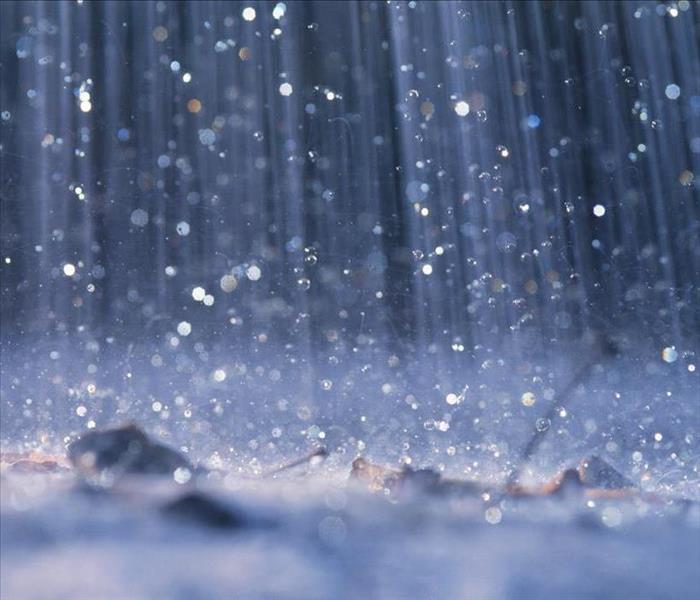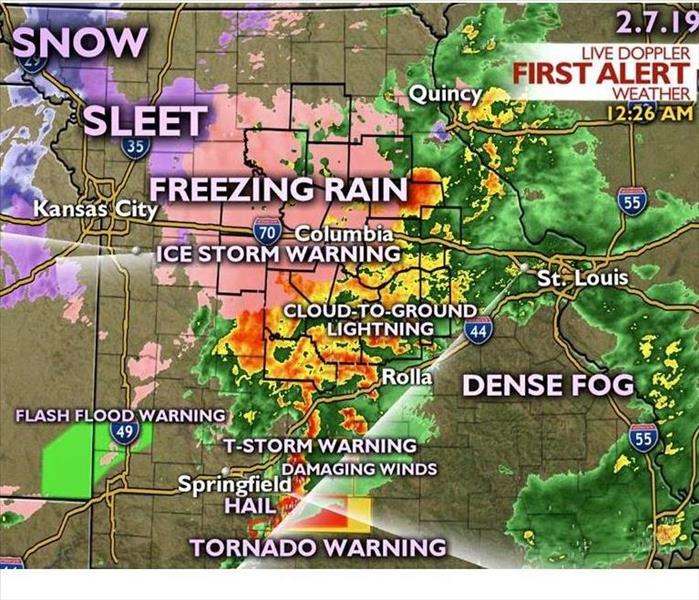Recent Storm Damage Posts
Flood Safety
6/7/2023 (Permalink)
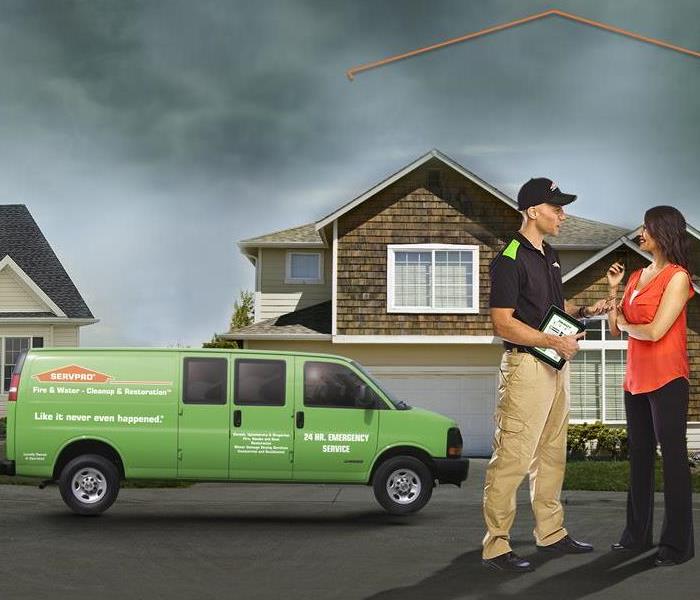 Storm
Storm
Spring and Summer in the Midwest are always a time for storms and it is important to know how to remain safe during high waters. Especially during flash floods and warnings.
The National Weather Service has some good tips for staying safe during high water and flood conditions.
Flood and Flash Flood Safety Rules:
Heavy rain should be a signal to alerting you to the possibility of dangerous flood conditions.
During periods of heavy rains, stay away from flood prone areas such as stream beds, drainage ditches and culverts.
Move to higher ground if flooding threatens your area.
If you live or work in flood prone areas, remain alert during periods of heavy rain.
Be especially cautious at night as it is harder to recognize flood dangers.
Never drive your car into water of unknown depth. Most flash flood deaths occur when people drive their vehicles into flood waters. Remember: Turn Around Don't Drown!!
If your vehicle stalls, abandon it immediately and seek higher ground. Flood water may rise quickly, cover the vehicle and sweep it away.
Stay out of flooded areas. The water may still be rising and very swift. A rapidly flowing stream can sweep you off your feet and sweep your vehicle downstream.
Children are especially vulnerable and should not be allowed to play in or around flowing water.
Water can run off streets and parking lots rapidly, causing natural and man-made drainage systems to overflow with flood waters.
Flood waters can hide rocks, trees, trash and other debris that can be dangerous to someone in their path.
Water is a very powerful force and should NEVER be underestimated.
Flood Watch:
When conditions look favorable for flash flooding, the National Weather Service will issue a Flood Watch, highlighting flash flood potential in and around the specified area. A Watch usually encompasses several counties. This is the time to start thinking about your plan of action if water begins to rise or a flash flood warning is issued.
Flash Flood Warning:
issued for a smaller, more specific area. This is when you must act quickly as flash floods are an imminent threat to you and your family. You may only have seconds to move to higher ground.
Plan Ahead for Severe Storms
5/22/2023 (Permalink)
 SERVPRO graphic
SERVPRO graphic
In the United States, there are around 100,000 thunderstorms every year, so these frightening events occur frequently in every state.
With all the crazy weather the Midwest has in the spring and summer, it is always better to be prepared and know how to stay safe ahead of time. It’s true that we can’t control the weather, but we can do our best to protect ourselves against its harmful blow.
You need to have a severe weather communication in place consisting of the following items:
First, you need to have a way to communicate with everyone in your home and also people outside your home. This way, you can receive weather alerts, such as watches and warnings.
Next, be sure to grab both your cell phone and an NOAA weather radio. Having multiple modes of communication could be a lifesaver.
Last, put together a communication strategy for your household that includes a designated safe area in your home for bad weather and a way for absent family members to check in and let you know they’re safe.
<h3severe-weather-emergency-kit">Your Severe Weather Emergency Kit
Every household needs an emergency kit jam-packed with all the essentials. Include food, water, first-aid supplies and anything else you might need.
Make sure it includes at least 72 hours worth of materials because you never know how long you might be stuck sheltering in place.
<h3severe-weather-aftermath-checklist">Your Severe Weather Aftermath Checklist
Once it’s all over, here’s what you need to do:
Talk to everyone about the communications plan and gather feedback on all the elements. This will help you improve the plan in the future and keep you even safer.
Next, go around your home and evaluate it for storm damage, paying close attention to all the vulnerable areas.
If you discover damage, turn SERVPRO so that you can count on a quick response that will bring about peace of mind and get your home back to pre-storm condition in no time!
If you discover storm damage to your home or business, you can count on SERVPRO to handle the restoration. We’re here 24⁄7 to spring into action.
Saving water damaged wallpaper
5/1/2023 (Permalink)
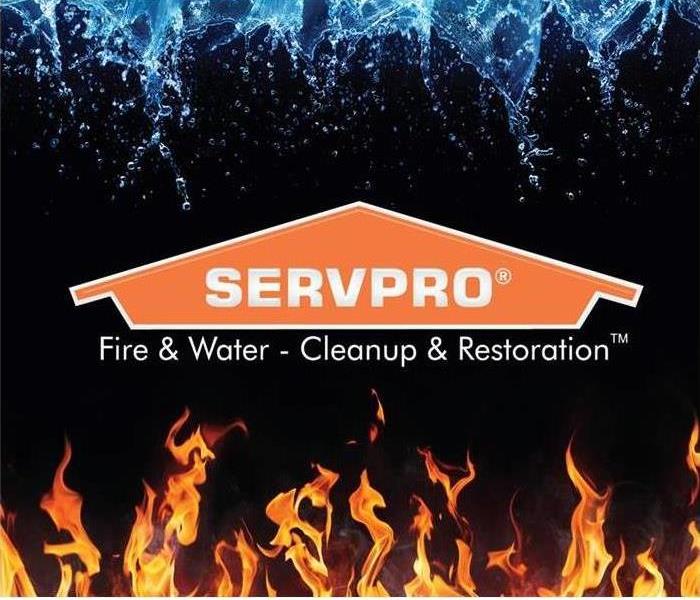 Saving water damaged wallpaper
Saving water damaged wallpaper
SERVPRO of Leavenworth and NW Wyandotte County knows that when you have a water damage in your home or business it can be overwhelming. And we are here to help clean up the damage and answer any questions you might have.
One important question we get asked often is can we save water damaged wallpaper. When your walls are wet, wallpaper acts as a vapor barrier and restricts our ability to dry it. Special drying measures may be needed when this wallpaper barrier is present, and depending on the extent of the damage we may or may not be able to save the wallpaper.
Some options are:
Removing the baseboard to ventilate the wall
Perforating the wall to ventilate it
Peeling away wallpaper to expose wet the drywall
Flood Safety
6/7/2022 (Permalink)
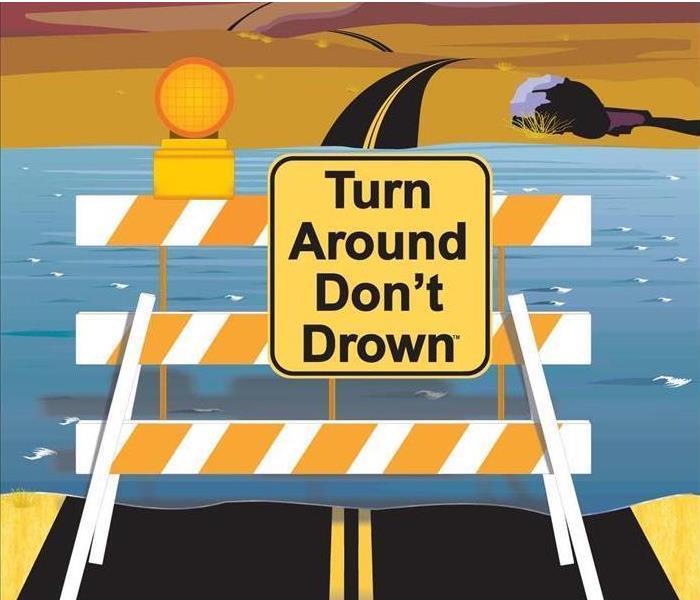 Flood Safety
Flood Safety
Spring and Summer in the Midwest are always a time for storms and it is important to know how to remain safe during high waters. Especially during flash floods and warnings.
The National Weather Service has some good tips for staying safe during high water and flood conditions.
Flood and Flash Flood Safety Rules:
Heavy rain should be a signal to alerting you to the possibility of dangerous flood conditions.
During periods of heavy rains, stay away from flood prone areas such as stream beds, drainage ditches and culverts.
Move to higher ground if flooding threatens your area.
If you live or work in flood prone areas, remain alert during periods of heavy rain.
Be especially cautious at night as it is harder to recognize flood dangers.
Never drive your car into water of unknown depth. Most flash flood deaths occur when people drive their vehicles into flood waters. Remember: Turn Around Don't Drown!!
If your vehicle stalls, abandon it immediately and seek higher ground. Flood water may rise quickly, cover the vehicle and sweep it away.
Stay out of flooded areas. The water may still be rising and very swift. A rapidly flowing stream can sweep you off your feet and sweep your vehicle downstream.
Children are especially vulnerable and should not be allowed to play in or around flowing water.
Water can run off streets and parking lots rapidly, causing natural and man-made drainage systems to overflow with flood waters.
Flood waters can hide rocks, trees, trash and other debris that can be dangerous to someone in their path.
Water is a very powerful force and should NEVER be underestimated.
Flood Watch:
When conditions look favorable for flash flooding, the National Weather Service will issue a Flood Watch, highlighting flash flood potential in and around the specified area. A Watch usually encompasses several counties. This is the time to start thinking about your plan of action if water begins to rise or a flash flood warning is issued.
Flash Flood Warning:
issued for a smaller, more specific area. This is when you must act quickly as flash floods are an imminent threat to you and your family. You may only have seconds to move to higher ground.
Plan Ahead for Severe Storms
5/5/2022 (Permalink)
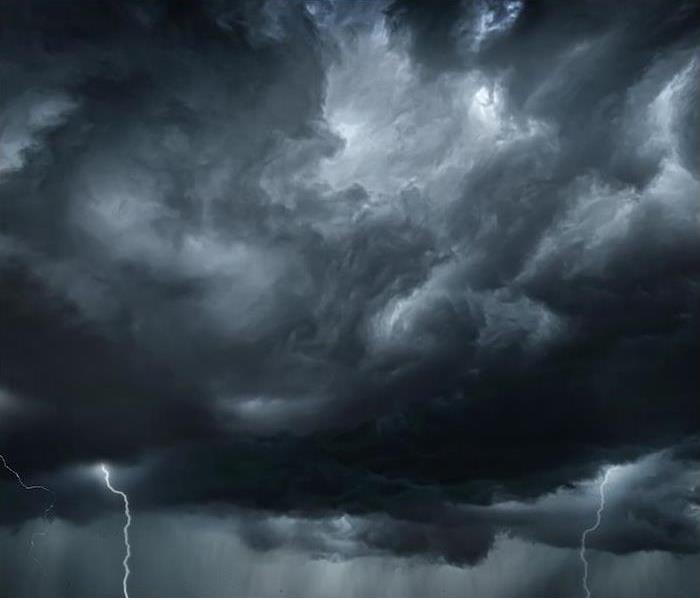 Plan Ahead for Severe Storms
Plan Ahead for Severe Storms
In the United States, there are around 100,000 thunderstorms every year, so these frightening events occur frequently in every state.
With all the crazy weather the Midwest has in the spring and summer, it is always better to be prepared and know how to stay safe ahead of time. It’s true that we can’t control the weather, but we can do our best to protect ourselves against its harmful blow.
Below are the ways in which you can reduce storms’ impacts on you and your home.
Your Severe Weather Communication StrategyYou need to have a severe weather communication in place consisting of the following items:
First, you need to have a way to communicate with everyone in your home and also people outside your home. This way, you can receive weather alerts, such as watches and warnings.
Next, be sure to grab both your cell phone and an NOAA weather radio. Having multiple modes of communication could be a lifesaver.
Last, put together a communication strategy for your household that includes a designated safe area in your home for bad weather and a way for absent family members to check in and let you know they’re safe.
Your Severe Weather Emergency KitEvery household needs an emergency kit jam-packed with all the essentials. Include food, water, first-aid supplies and anything else you might need.
Make sure it includes at least 72 hours worth of materials because you never know how long you might be stuck sheltering in place.
Your Severe Weather Aftermath ChecklistOnce it’s all over, here’s what you need to do:
Talk to everyone about the communications plan and gather feedback on all the elements. This will help you improve the plan in the future and keep you even safer.
Next, go around your home and evaluate it for storm damage, paying close attention to all the vulnerable areas.
If you discover damage, turn SERVPRO so that you can count on a quick response that will bring about peace of mind and get your home back to pre-storm condition in no time!
If you discover storm damage to your home or business, you can count on SERVPRO to handle the restoration. We’re here 24⁄7 to spring into action
Saving water damaged wall paper
4/29/2022 (Permalink)
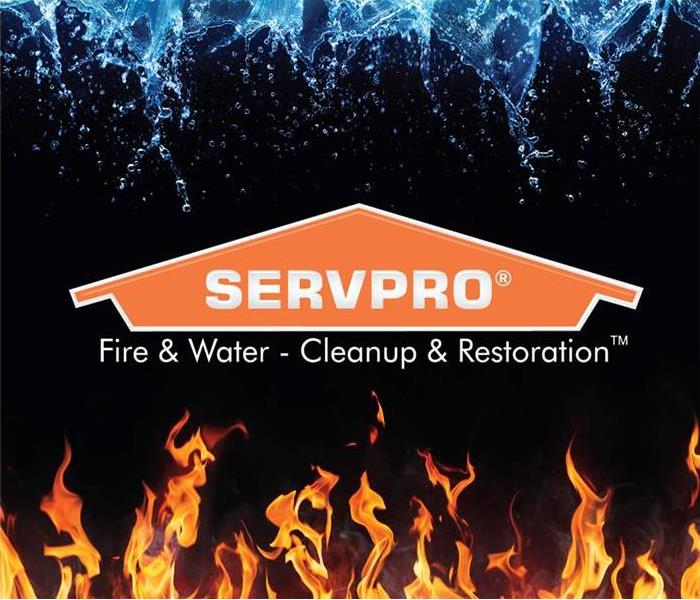 Saving water damaged wall paper
Saving water damaged wall paper
SERVPRO of Leavenworth and NW Wyandotte County knows that when you have a water damage in your home or business it can be overwhelming. And we are here to help clean up the damage and answer any questions you might have.
One important question we get asked often is can we save water damaged wallpaper. When your walls are wet, wallpaper acts as a vapor barrier and restricts our ability to dry it. Special drying measures may be needed when this wallpaper barrier is present, and depending on the extent of the damage we may or may not be able to save the wallpaper.
Some options are:
Removing the baseboard to ventilate the wall
Perforating the wall to ventilate it
Peeling away wallpaper to expose wet the drywall
Protecting Furniture from Water Damage
4/23/2022 (Permalink)
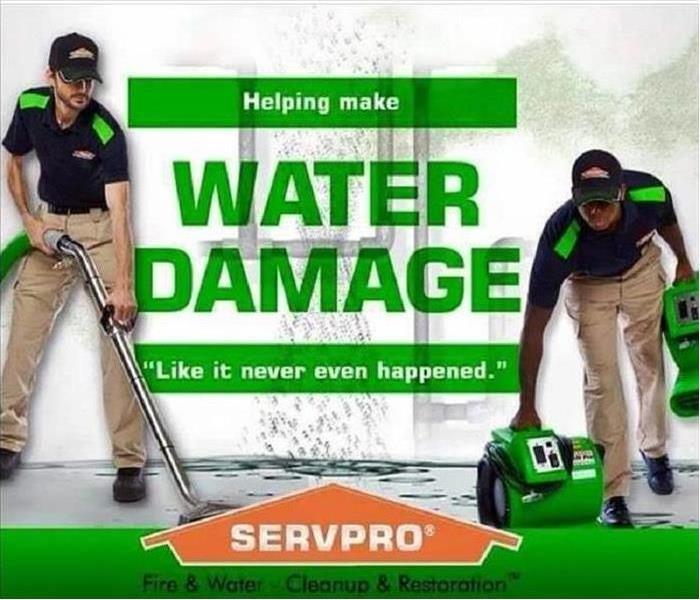 Protecting Furniture from Water Damage
Protecting Furniture from Water Damage
When natural disasters strike, it is extremely important to be prepared. That is why SERVPRO of Leavenworth and NW Wyandotte County is open 24/7 and 365. And although we are always here to help, there are some things you can do between the time you call us and the time we arrive. One important thing you can do is take steps to protect valuable furniture when you experience light flooding or a small water loss in your home. See our tips below!
Use wooden blocks: Place wood blocks under your furniture legs to keep it high above rising waters
Use aluminum foil: wrap wooden furniture legs in aluminum foil to protect them from rising water
Use plastic container lids: If the water damage is minimal you can put old plastic container lids or tupperware lids as a barrier between the water and your furniture
3 Types of Floods & Their Main Causes
4/12/2022 (Permalink)
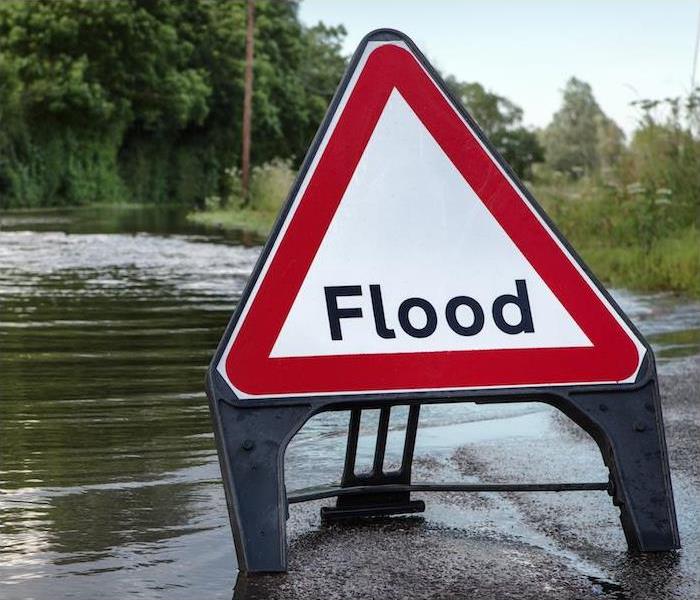 3 Types of Floods & Their Main Causes
3 Types of Floods & Their Main Causes
Flooding is the most common natural disaster, and it claims more lives in the United States per year than hurricanes, tornadoes or lightning. It can affect everything from individual homes where property collects excess water to wide swaths of communities and cities.
Despite the fact that flooding affects all 50 states and all U.S. territories, there are similarities in the types and causes of floods. Floods happen for four typical reasons, and there are three main types.
3 Types of Natural Flooding
Flash floods are common, and they happen when heavy rain passes or sits over an area and overwhelms the ability of the ground to contain the moisture. Excess water runs off and takes garbage cans, cars and more with it.
River floods are exactly what they sound like. When there’s too much water for a river’s banks to hold, the water spills over the sides and causes destruction.
Coastal floods happen in areas next to large bodies of water, when storm surges or cyclonic activity causes ocean or gulf levels to rise to flood levels.
The 4 Most Common Causes of Natural Flooding
Heavy rainfall. Storms with excessive rainfall, or storms that sit and rest over an area for an extended period can cause flash floods or river flooding. Urban areas are more at risk for rain floods, because the higher percentage of concrete and asphalt means there’s a lack of soil to soak up all that water.
Oceanic activity. Storm surges, hurricanes and rising tides can cause water levels to rise in waves, which can invade coastal communities and wreak havoc.
Dams and levees failing. The most notable example of this in recent history would be the disastrous levee breaks during 2005’s Hurricane Katrina. Levees and dams fail when cracks occur or excess pressure overtakes the dam’s ability to contain the surge of water behind it. Similarly, in 1951, Topeka experienced a severe flood after the raging waters of the Kansas River broke through a dike to flood the North Topeka Business district. According to the National Weather Service, the Kansas River reached its highest level on record. In all, 40 Kansans lost their lives in what was known as the “Flood of the Century.”
Snowmelts and ice dams. In areas of the country where heavy snow and prolonged freezing temperatures are common, snow and ice can build up over a winter’s time, and when they start to melt, they cause rivers of water to flow through area communities. Ice dams or ice jams happen when rivers become blocked by built-up ice being carried downstream, causing the banks to overflow.
Regardless of the cause of the flooding, SERVPRO has the tools and teams to help your home or business recover from its disastrous effects. Contact us anytime when flooding or water damage makes a mess in your life.
Preparing for Tornado Season
3/27/2022 (Permalink)
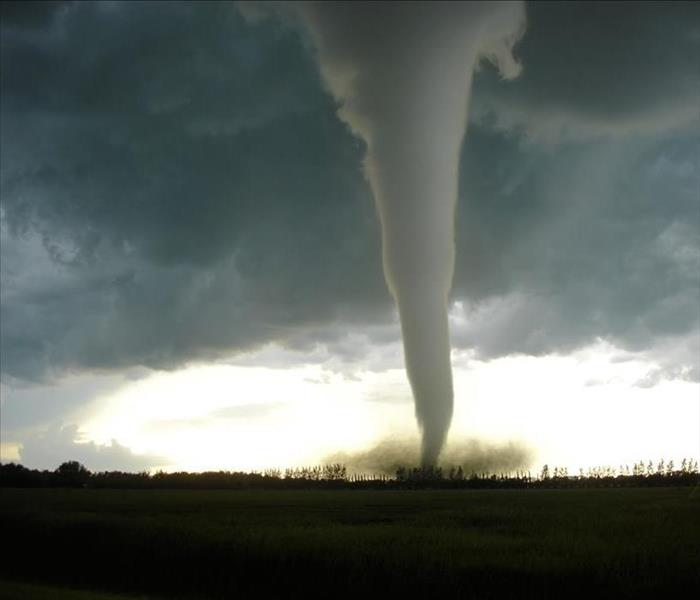 Preparing for Tornado Season
Preparing for Tornado Season
This page explains what actions to take when you receive a tornado watch or warning alert from the National Weather Service for your local area and what to do before, during, and after a tornado.
Know your risk
What
A tornado is a violently rotating column of air that extends from a thunderstorm to the ground and is often—although not always—visible as a funnel cloud. Lightning and hail are common in thunderstorms that produce tornadoes. Tornadoes cause extensive damage to structures and disrupt transportation, power, water, gas, communications, and other services in its direct path and in neighboring areas. Related thunderstorms can cause heavy rains, flash flooding, and hail
Where
About 1,200 tornadoes hit the United States every year and every state is at risk. Most tornadoes in the United States occur east of the Rocky Mountains with concentrations in the central and southern plains, the Gulf Coast and Florida.
When
Tornadoes can strike in any season, but occur most often in the spring and summer months. They can occur at all hours of the day and night, but are most likely to occur between 3 p.m. and 9 p.m.
Before a Tornado
Identify safe rooms built to FEMA criteria or ICC500 storm shelters or other potential protective locations in sturdy buildings near your home, work, and other locations you frequent so you have a plan for where you will go quickly for safety when there is a Warning or an approaching tornado.
For schools, malls, and other buildings with long-span roofs or open space plans, or many occupants, ask the building manager to identify the best available refuge.
Build an emergency kit and make a family communications plan.
Listen to NOAA Weather Radio or to commercial radio or television newscasts for the latest information. In any emergency, always listen to the instructions given by local emergency management officials.
Be alert to changing weather conditions. Look for approaching storms.
Look for the following danger signs:
Dark, often greenish sky
Large hail
A large, dark, low-lying cloud (particularly if rotating)
Loud roar, similar to a freight train.
If you see approaching storms or any of the danger signs, be prepared to take shelter immediately.
If your home is without power, use flashlights or battery-powered lanterns rather than candles to prevent accidental fires.
Kansas weather can be unpredictable! Be informed & stay safe!
If tragedy strikes remember, SERVPRO of Leavenworth & NW Wyandotte County is always here to help!
913-772-1818
Examining Spring Weather Threats in the United States
3/15/2022 (Permalink)
 Examining Spring Weather Threats in the United States
Examining Spring Weather Threats in the United States
According to World Atlas, the U.S. is the third-largest country in the world, behind Russia and Canada, in terms of total land area (though China is bigger if you don’t include all of the United States’ outlying regions).
With such a large region under one cover, seasonal weather is not uniform—different parts of the nation face varying weather patterns, and hence variable degrees of weather threats.
As spring approaches and warm and cold air masses meet throughout the country, let’s take a look at the many weather events that may be anticipated in a few major geographical regions, and also, what we need to be aware of here in Kansas.
The Pacific Northwest’s spring months are prone to severe rain, which may result in floods and water damage. Higher altitudes will continue to have snow, and the melting and runoff from that will create issues of its own.
Winter’s chill lasts the longest in the Upper Midwest and Northeast, and chilly weather will persist there throughout the season. Residents from Maine to the Dakotas can anticipate very cold weather and the threat of snowstorms and blizzards until late spring or possibly early summer.
On the other hand, the southern West Coast will have to watch out for excessive heat waves that could endanger lives and property, while the South Pacific, including Hawaii, will be on the lookout for potential tsunamis caused by tectonic action.
The central United States, from Iowa to Texas, including Kansas, will need to be vigilant for windstorms, derechos, and the threat of wildfires, which can readily spread when winds are strong and seasons are dry. And, of course, a large portion of this territory is Tornado Alley, an area with a high frequency of tornadoes.
Due to our state’s location, the mixing of cold, dry air from the north with warm, moist air from the Gulf of Mexico, violent thunderstorms are frequent in Kansas. Several of these thunderstorms have the potential to generate large hail, damaging winds and tornadoes. Between 1991 and 2010, the state averaged slightly under 100 tornadoes per year, which sometimes caused considerable damage and loss of life.
Finally, the Southeast may be subjected to a variety of extreme weather events, ranging from tornadoes and severe thunderstorms in landlocked states to hazardous rip currents and hurricanes later in the spring.
Regardless of where you reside in the United States, the possibility of severe weather exists. Yours may differ from that of a relative a few states away, but it never hurts to be aware and prepared.
If extreme weather leaves you with damage from water, fire or other elements, help is a click away. Contact SERVPRO for fast, expert recovery.
Storm Water Damage Cleanup
8/19/2021 (Permalink)
 Storm Water Damage Cleanup
Storm Water Damage Cleanup
SERVPRO of Leavenworth and NW Wyandotte County knows that here in the Midwest you never know when a natural disaster is going to strike. Between the summer storms, tornado season, and the up and down temperatures in the winter (and all year long if we are being honest) it is hard to be prepared when disaster strikes. That is why SERVPRO is always here to help! We know that a fast response is a critical factor in reducing damage and restoring water damaged materials.
Not only does SERVPRO pride ourselves on our quick response times, we also have STORM Extreme Teams always waiting in the wings to help out in the event of a large natural disaster.
SERVPRO's STORM Teams are comprised of highly trained technicians ready to roll out to anywhere in the country in the event of a giant natural disaster.
So remember, you can always count of SERVPRO to faster to any size disaster!
Flood Safety
6/6/2021 (Permalink)
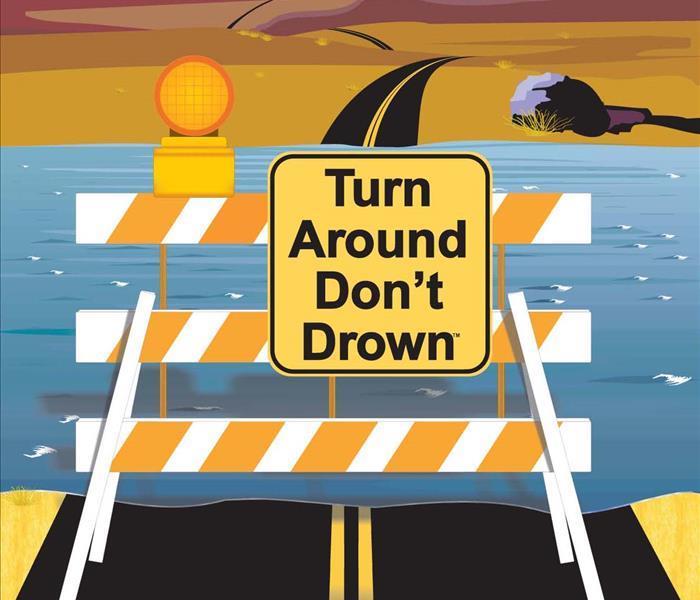 Flood Safety
Flood Safety
Spring and Summer in the Midwest are always a time for storms and it is important to know how to remain safe during high waters. Especially during flash floods and warnings.
The National Weather Service has some good tips for staying safe during high water and flood conditions.
Flood and Flash Flood Safety Rules:
Heavy rain should be a signal to alerting you to the possibility of dangerous flood conditions.
During periods of heavy rains, stay away from flood prone areas such as stream beds, drainage ditches and culverts.
Move to higher ground if flooding threatens your area.
If you live or work in flood prone areas, remain alert during periods of heavy rain.
Be especially cautious at night as it is harder to recognize flood dangers.
Never drive your car into water of unknown depth. Most flash flood deaths occur when people drive their vehicles into flood waters. Remember: Turn Around Don't Drown!!
If your vehicle stalls, abandon it immediately and seek higher ground. Flood water may rise quickly, cover the vehicle and sweep it away.
Stay out of flooded areas. The water may still be rising and very swift. A rapidly flowing stream can sweep you off your feet and sweep your vehicle downstream.
Children are especially vulnerable and should not be allowed to play in or around flowing water.
Water can run off streets and parking lots rapidly, causing natural and man-made drainage systems to overflow with flood waters.
Flood waters can hide rocks, trees, trash and other debris that can be dangerous to someone in their path.
Water is a very powerful force and should NEVER be underestimated.
Flood Watch:
When conditions look favorable for flash flooding, the National Weather Service will issue a Flood Watch, highlighting flash flood potential in and around the specified area. A Watch usually encompasses several counties. This is the time to start thinking about your plan of action if water begins to rise or a flash flood warning is issued.
Flash Flood Warning:
issued for a smaller, more specific area. This is when you must act quickly as flash floods are an imminent threat to you and your family. You may only have seconds to move to higher ground.
Water Damage on Wallpaper
4/28/2021 (Permalink)
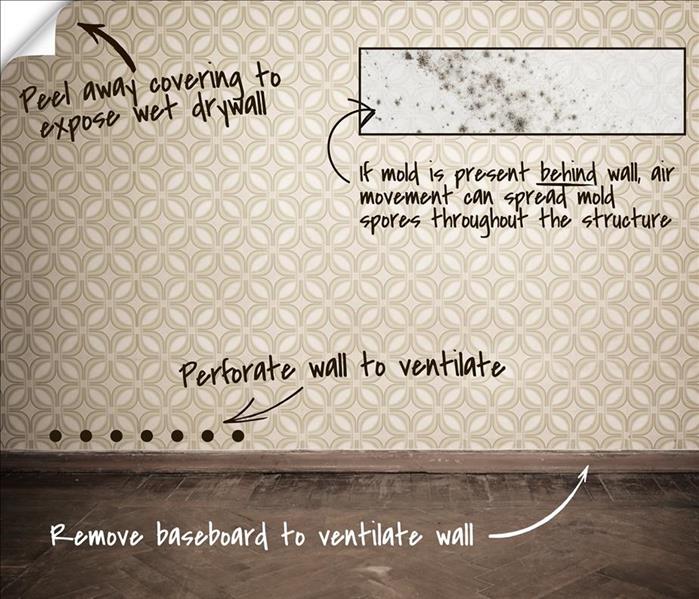 Water Damage on Wallpaper
Water Damage on Wallpaper
SERVPRO of Leavenworth and NW Wyandotte County knows that when you have a water damage in your home or business it can be overwhelming. And we are here to help clean up the damage and answer any questions you might have.
One important question we get asked often is can we save water damaged wallpaper. When your walls are wet, wallpaper acts as a vapor barrier and restricts our ability to dry it. Special drying measures may be needed when this wallpaper barrier is present, and depending on the extent of the damage we may or may not be able to save the wallpaper.
Some options are:
Removing the baseboard to ventilate the wall
Perforating the wall to ventilate it
Peeling away wallpaper to expose wet the drywall
How to protect furniture from water damage
4/22/2021 (Permalink)
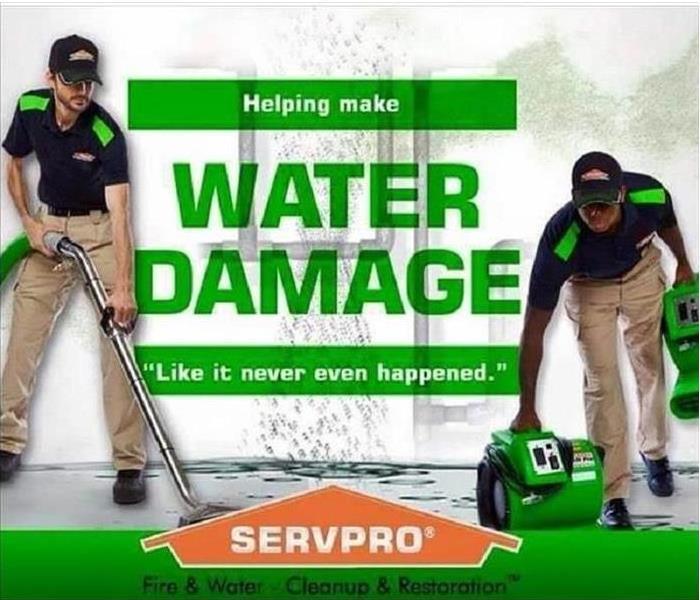 How to protect furniture from water damage
How to protect furniture from water damage
When natural disasters strike, it is extremely important to be prepared. That is why SERVPRO is open 24/7 and 365. And although we are always here to help, there are some things you can do between the time you call us and the time we arrive. One important thing you can do is take steps to protect valuable furniture when you experience light flooding or a small water loss in your home. See our tips below!
Use wooden blocks: Place wood blocks under your furniture legs to keep it high above rising waters
Use aluminum foil: wrap wooden furniture legs in aluminum foil to protect them from rising water
Use plastic container lids: If the water damage is minimal you can put old plastic container lids or tupperware lids as a barrier between the water and your furniture
Flood Damage Safety
4/20/2021 (Permalink)
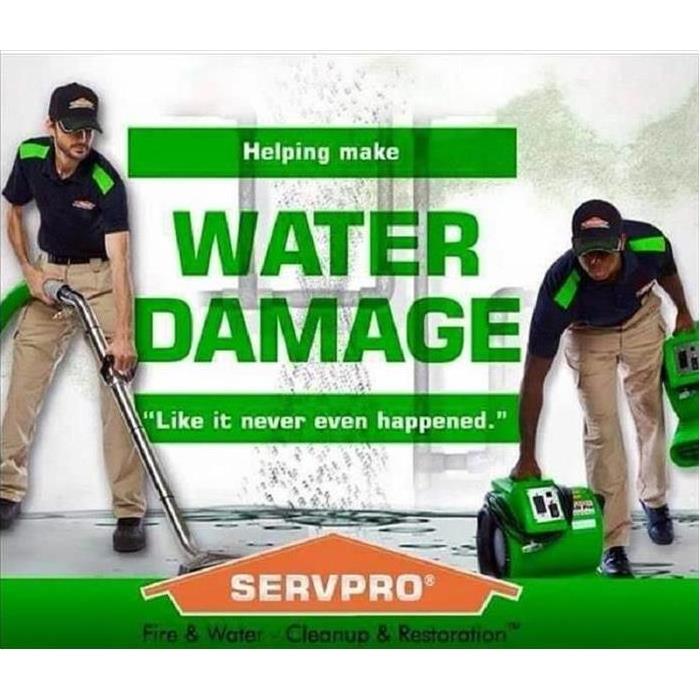 Flood Damage Safety
Flood Damage Safety
SERVPRO of Leavenworth and NW Wyandotte County knows that in these uncertain times some things always remain the same. And one of those things is unexpected damage to your home. And whether that damage is from a rain storm, a tornado, or a broken refrigerator line, SERVPRO is here to help! If you experience a water loss or a flood, one of the most important things you can do is to identify potential hazards as soon as possible.
Here are a few to remember:
Ceiling: If water damage has occurred to your roof/ceiling, the ceiling/roof could potentially be unstable
Electrical shock hazards: Lights can indicate if the power is still on and if the area is dangerous. DO NOT touch any sockets or switches to check if the lights are on
Contaminated water
Hidden hazards in the water
Preparing for Tornado Season
3/26/2021 (Permalink)
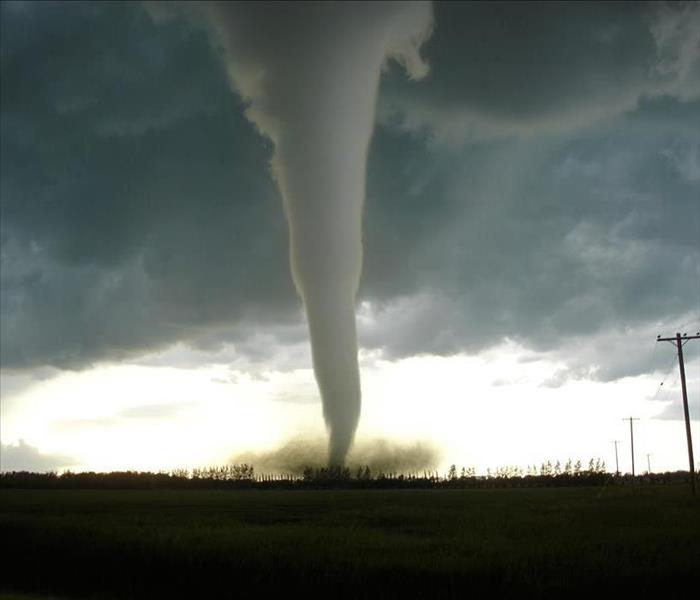 Preparing for Tornado Season
Preparing for Tornado Season
This page explains what actions to take when you receive a tornado watch or warning alert from the National Weather Service for your local area and what to do before, during, and after a tornado.
Know your risk
What
A tornado is a violently rotating column of air that extends from a thunderstorm to the ground and is often—although not always—visible as a funnel cloud. Lightning and hail are common in thunderstorms that produce tornadoes. Tornadoes cause extensive damage to structures and disrupt transportation, power, water, gas, communications, and other services in its direct path and in neighboring areas. Related thunderstorms can cause heavy rains, flash flooding, and hail
Where
About 1,200 tornadoes hit the United States every year and every state is at risk. Most tornadoes in the United States occur east of the Rocky Mountains with concentrations in the central and southern plains, the Gulf Coast and Florida.
When
Tornadoes can strike in any season, but occur most often in the spring and summer months. They can occur at all hours of the day and night, but are most likely to occur between 3 p.m. and 9 p.m.
Before a Tornado
Identify safe rooms built to FEMA criteria or ICC500 storm shelters or other potential protective locations in sturdy buildings near your home, work, and other locations you frequent so you have a plan for where you will go quickly for safety when there is a Warning or an approaching tornado.
For schools, malls, and other buildings with long-span roofs or open space plans, or many occupants, ask the building manager to identify the best available refuge.
Build an emergency kit and make a family communications plan.
Listen to NOAA Weather Radio or to commercial radio or television newscasts for the latest information. In any emergency, always listen to the instructions given by local emergency management officials.
Be alert to changing weather conditions. Look for approaching storms.
Look for the following danger signs:
Dark, often greenish sky
Large hail
A large, dark, low-lying cloud (particularly if rotating)
Loud roar, similar to a freight train.
If you see approaching storms or any of the danger signs, be prepared to take shelter immediately.
If your home is without power, use flashlights or battery-powered lanterns rather than candles to prevent accidental fires.
Kansas weather can be unpredictable! Be informed & stay safe!
If tragedy strikes remember, SERVPRO of Leavenworth & NW Wyandotte County is always here to help!
913-772-1818
Storm Warning
12/30/2020 (Permalink)
 Storm Warning
Storm Warning
As all of us in the Midwest know winter weather can cause unforeseen damage to your residential or commercial property. Snow and ice storms as well as other issues can be a huge problem this time of year. Here are a few tips to avoid property damage this winter.
Protect your Pipes
Frozen pipes can cause major issues. When water freezes it expands. When frozen in a pipe it can cause the pipe to burst, water escapes and serious property damage can be had.
Make sure all pipes that are outside your home, near exterior walls or in unheated spaces are insulated.
Be sure to keep the heat on so pipes in other areas of your home don’t freeze. In extreme conditions open cabinet doors to let warm air under the kitchen or bathroom sinks.
Keep Gutters Clean
Make sure there is no debris in your gutters and they are attached securely to your home. Snow and Ice can build up in your gutter making them heavy and if not properly attached can cause damage by the weight pulling them down.
Ventilate your Attic
Making sure your attic is properly ventilated can prevent ice dams in the winter. An unvented attic can generate an excessive amount of heat. When the snow and ice melts it can refreeze along the edge of your roof causing ice dams to form. It can also lead to structural damage to exterior walls by getting into cracks and holes. When vented properly your roof can remain cooler through the winter and thereby avoiding potential ice dams from forming.
Trim Trees
Cutting back dead tree limbs before winter weather is best. The weight of snow and ice can cause them to break easily and can cause damage to your roof, windows, vehicles and even people below.
Disaster Master
12/16/2020 (Permalink)
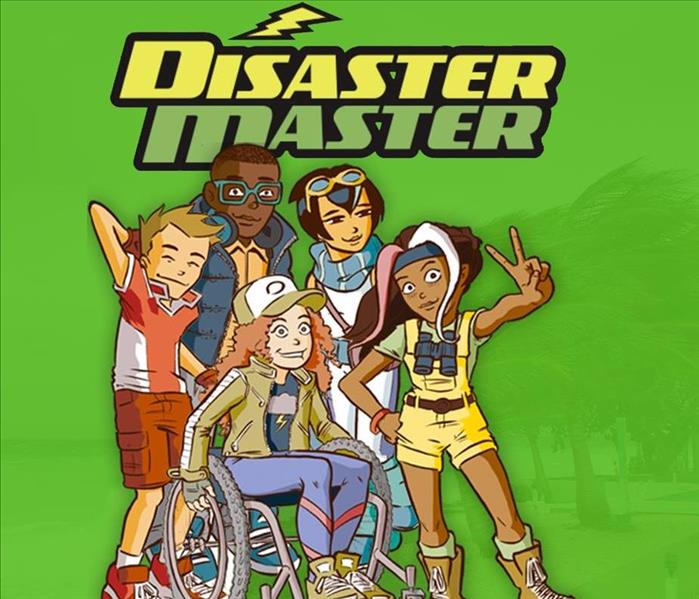 Disaster Master
Disaster Master
SERVPRO of Leavenworth and NW Wyandotte County knows the importance of continuing education when it comes to disaster awareness. SERVPRO offers all kinds of classes to keep adults up to date and informed but it is also important to make sure your kids know what to do in the event of a disaster as well. By helping prepare your kids and set up a line of communication you will ensure that you are all as prepared as possible to stay safe during any kind of disaster. A great resource for helping them learn is Disaster Master, by Ready.gov. Your kids will learn the best ways to handle wildfires, tornadoes, hurricanes, blackouts, home fires, winter storms and extreme cold, earthquakes, thunderstorms, and more! Play now -> http://bit.ly/DisMas. They also get to print their own graphic novel at the end!
Flood Safety 101
6/4/2020 (Permalink)
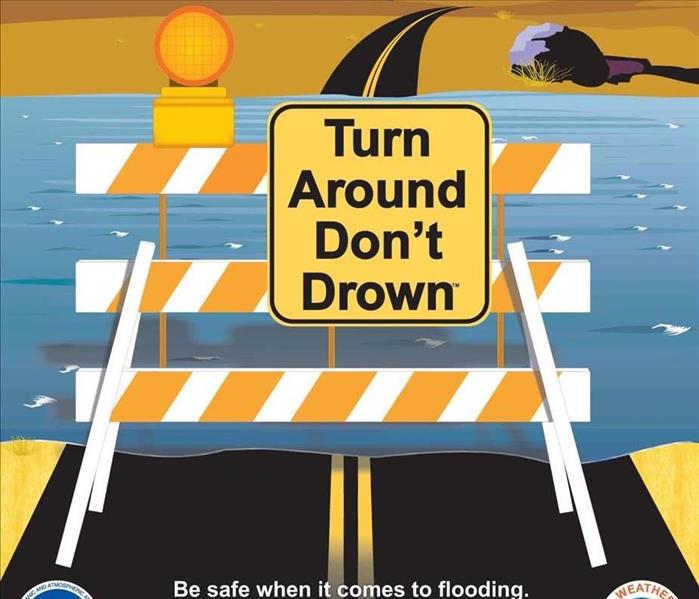 Flood Safety 101
Flood Safety 101
Spring and Summer in the Midwest are always a time for storms and it is important to know how to remain safe during high waters. Especially during flash floods and warnings.
The National Weather Service has some good tips for staying safe during high water and flood conditions.
Flood and Flash Flood Safety Rules:
Heavy rain should be a signal to alerting you to the possibility of dangerous flood conditions.
During periods of heavy rains, stay away from flood prone areas such as stream beds, drainage ditches and culverts.
Move to higher ground if flooding threatens your area.
If you live or work in flood prone areas, remain alert during periods of heavy rain.
Be especially cautious at night as it is harder to recognize flood dangers.
Never drive your car into water of unknown depth. Most flash flood deaths occur when people drive their vehicles into flood waters. Remember: Turn Around Don't Drown!!
If your vehicle stalls, abandon it immediately and seek higher ground. Flood water may rise quickly, cover the vehicle and sweep it away.
Stay out of flooded areas. The water may still be rising and very swift. A rapidly flowing stream can sweep you off your feet and sweep your vehicle downstream.
Children are especially vulnerable and should not be allowed to play in or around flowing water.
Water can run off streets and parking lots rapidly, causing natural and man-made drainage systems to overflow with flood waters.
Flood waters can hide rocks, trees, trash and other debris that can be dangerous to someone in their path.
Water is a very powerful force and should NEVER be underestimated.
Flood Watch:
When conditions look favorable for flash flooding, the National Weather Service will issue a Flood Watch, highlighting flash flood potential in and around the specified area. A Watch usually encompasses several counties. This is the time to start thinking about your plan of action if water begins to rise or a flash flood warning is issued.
Flash Flood Warning:
issued for a smaller, more specific area. This is when you must act quickly as flash floods are an imminent threat to you and your family. You may only have seconds to move to higher ground.
Flood Damage Safety
4/15/2020 (Permalink)
 Flood Damage Safety
Flood Damage Safety
SERVPRO of Leavenworth and NW Wyandotte County knows that in these uncertain times some things always remain the same. And one of those things is unexpected damage to your home. And whether that damage is from a rain storm, a tornado, or a broken refrigerator line, SERVPRO is here to help! If you experience a water loss or a flood, one of the most important things you can do is to identify potential hazards as soon as possible.
Here are a few to remember:
Ceiling: If water damage has occurred to your roof/ceiling, the ceiling/roof could potentially be unstable
Electrical shock hazards: Lights can indicate if the power is still on and if the area is dangerous. DO NOT touch any sockets or switches to check if the lights are on
Contaminated water
Hidden hazards in the water
Natural Disasters can happen to you
3/26/2020 (Permalink)
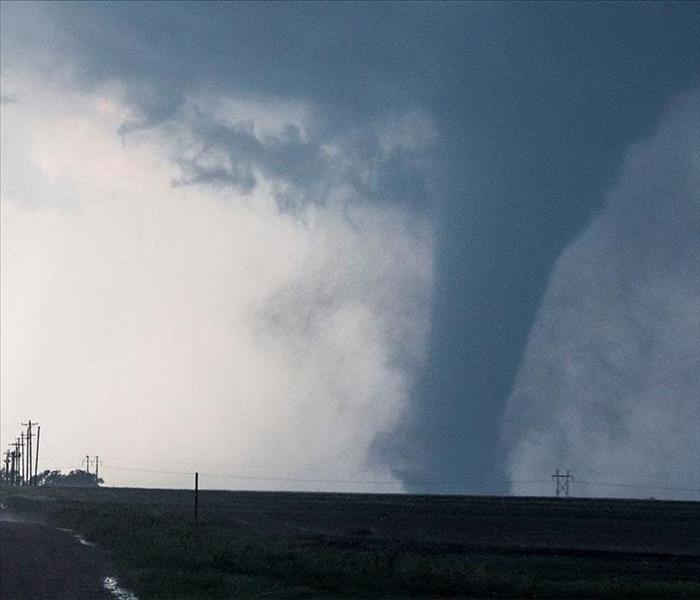 Natural Disasters can happen to you
Natural Disasters can happen to you
This page explains what actions to take when you receive a tornado watch or warning alert from the National Weather Service for your local area and what to do before, during, and after a tornado.
Know your risk
What
A tornado is a violently rotating column of air that extends from a thunderstorm to the ground and is often—although not always—visible as a funnel cloud. Lightning and hail are common in thunderstorms that produce tornadoes. Tornadoes cause extensive damage to structures and disrupt transportation, power, water, gas, communications, and other services in its direct path and in neighboring areas. Related thunderstorms can cause heavy rains, flash flooding, and hail
Where
About 1,200 tornadoes hit the United States every year and every state is at risk. Most tornadoes in the United States occur east of the Rocky Mountains with concentrations in the central and southern plains, the Gulf Coast and Florida.
When
Tornadoes can strike in any season, but occur most often in the spring and summer months. They can occur at all hours of the day and night, but are most likely to occur between 3 p.m. and 9 p.m.
Before a Tornado
Identify safe rooms built to FEMA criteria or ICC500 storm shelters or other potential protective locations in sturdy buildings near your home, work, and other locations you frequent so you have a plan for where you will go quickly for safety when there is a Warning or an approaching tornado.
For schools, malls, and other buildings with long-span roofs or open space plans, or many occupants, ask the building manager to identify the best available refuge.
Build an emergency kit and make a family communications plan.
Listen to NOAA Weather Radio or to commercial radio or television newscasts for the latest information. In any emergency, always listen to the instructions given by local emergency management officials.
Be alert to changing weather conditions. Look for approaching storms.
Look for the following danger signs:
Dark, often greenish sky
Large hail
A large, dark, low-lying cloud (particularly if rotating)
Loud roar, similar to a freight train.
If you see approaching storms or any of the danger signs, be prepared to take shelter immediately.
If your home is without power, use flashlights or battery-powered lanterns rather than candles to prevent accidental fires.
Kansas weather can be unpredictable! Be informed & stay safe!
If tragedy strikes remember, SERVPRO of Leavenworth & NW Wyandotte County is always here to help!
913-772-1818
Midwest Weather
3/10/2020 (Permalink)
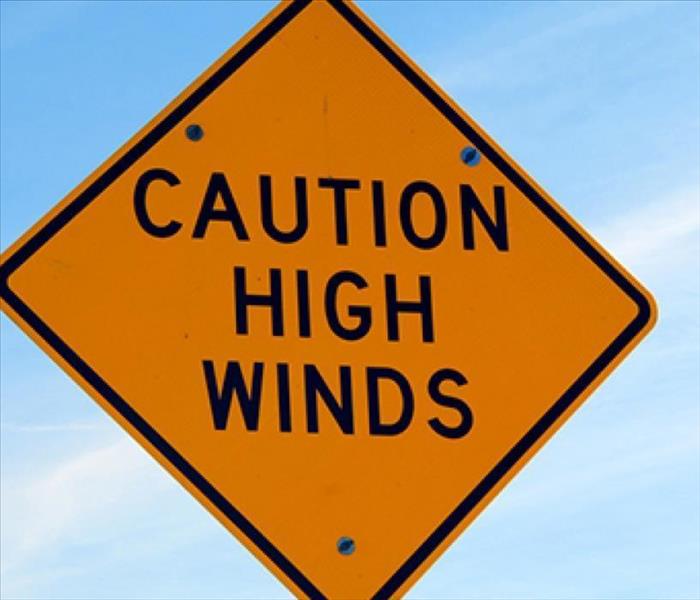 Midwestern weather
Midwestern weather
This time of year the weather in the Midwest is notoriously unpredictable-and let's be honest it's pretty much unpredictable all year round-and SERVPRO of Leavenworth and NW Wyandotte County is here to help you when disaster strikes. Whether that storm event comes in the form of frozen pipes, or tornadoes, or flooding, we are here to help 24 hours a day 7 days a week. With the recent drastic fluctuation in temperatures all areas of the United States have seen all kinds of storm damage and no matter where you are located there is likey to be a local SERVPRO Franchise ready and willing to help. To meet our highly trained crew of professional technicians just click here . And if you have any questions feel free to contact us at 913-772-1818.
Preparing the Next Generation
11/12/2019 (Permalink)
 Disaster Master prepares kids for all events
Disaster Master prepares kids for all events
SERVPRO of Leavenworth and NW Wyandotte County knows the importance of continuing education when it comes to disaster awareness. SERVPRO offers all kinds of classes to keep adults up to date and informed but it is also important to make sure your kids know what to do in the event of a disaster as well. By helping prepare your kids and set up a line of communication you will ensure that you are all as prepared as possible to stay safe during any kind of disaster. A great resource for helping them learn is Disaster Master, by Ready.gov. Your kids will learn the best ways to handle wildfires, tornadoes, hurricanes, blackouts, home fires, winter storms and extreme cold, earthquakes, thunderstorms, and more! Play now -> http://bit.ly/DisMas. They also get to print their own graphic novel at the end!
Preparing your home for winter storms
11/7/2019 (Permalink)
 Preparing your home for winter storms before the weather hits
Preparing your home for winter storms before the weather hits
As all of us in the Midwest know winter weather can cause unforeseen damage to your residential or commercial property. Snow and ice storms as well as other issues can be a huge problem this time of year. Here are a few tips to avoid property damage this winter.
Protect your Pipes
Frozen pipes can cause major issues. When water freezes it expands. When frozen in a pipe it can cause the pipe to burst, water escapes and serious property damage can be had.
Make sure all pipes that are outside your home, near exterior walls or in unheated spaces are insulated.
Be sure to keep the heat on so pipes in other areas of your home don’t freeze. In extreme conditions open cabinet doors to let warm air under the kitchen or bathroom sinks.
Keep Gutters Clean
Make sure there is no debris in your gutters and they are attached securely to your home. Snow and Ice can build up in your gutter making them heavy and if not properly attached can cause damage by the weight pulling them down.
Ventilate your Attic
Making sure your attic is properly ventilated can prevent ice dams in the winter. An unvented attic can generate an excessive amount of heat. When the snow and ice melts it can refreeze along the edge of your roof causing ice dams to form. It can also lead to structural damage to exterior walls by getting into cracks and holes. When vented properly your roof can remain cooler through the winter and thereby avoiding potential ice dams from forming.
Trim Trees
Cutting back dead tree limbs before winter weather is best. The weight of snow and ice can cause them to break easily and can cause damage to your roof, windows, vehicles and even people below.
Rain Rain Go Away
5/23/2019 (Permalink)
Hopefully the rain will let up soon, but with lots of thunder clouds still in the forecast it is important to know how to remain safe during high waters. Especially during flash floods and warnings.
The National Weather Service has some good tips for staying safe during high water and flood conditions.
Flood and Flash Flood Safety Rules:
Heavy rain should be a signal to alerting you to the possibility of dangerous flood conditions.
During periods of heavy rains, stay away from flood prone areas such as stream beds, drainage ditches and culverts.
Move to higher ground if flooding threatens your area.
If you live or work in flood prone areas, remain alert during periods of heavy rain.
Be especially cautious at night as it is harder to recognize flood dangers.
Never drive your car into water of unknown depth. Most flash flood deaths occur when people drive their vehicles into flood waters. Remember: Turn Around Don't Drown!!
If your vehicle stalls, abandon it immediately and seek higher ground. Flood water may rise quickly, cover the vehicle and sweep it away.
Stay out of flooded areas. The water may still be rising and very swift. A rapidly flowing stream can sweep you off your feet and sweep your vehicle downstream.
Children are especially vulnerable and should not be allowed to play in or around flowing water.
Water can run off streets and parking lots rapidly, causing natural and man-made drainage systems to overflow with flood waters.
Flood waters can hide rocks, trees, trash and other debris that can be dangerous to someone in their path.
Water is a very powerful force and should NEVER be underestimated.
Flood Watch:
When conditions look favorable for flash flooding, the National Weather Service will issue a Flood Watch, highlighting flash flood potential in and around the specified area. A Watch usually encompasses several counties. This is the time to start thinking about your plan of action if water begins to rise or a flash flood warning is issued.
Flash Flood Warning:
issued for a smaller, more specific area. This is when you must act quickly as flash floods are an imminent threat to you and your family. You may only have seconds to move to higher ground.
Can your sump pump handle it?
5/15/2019 (Permalink)
Keeping your sump pump working is an important part of keeping your basement dry. See below for tips on sump pump maintenance
Step 1: Inspect
Start by checking the sump pit for any debris that could interfere with your pump's operation. If there is an "oil slick" on the surface of the water, the pump could be releasing coolant and may need replacement. Unplug the pump and take a look at the intake on the pump, and clean it out if necessary.
Plug the pump back in. If you're plugging into a Ground Fault Circuit Interrupter (GFCI) outlet, make sure that it's fully operational. While newer GFCI outlets will alert you or stop working when their circuitry goes out, older outlets will not. Also, if you notice any frayed wires or exposed connections, have them repaired by a licensed electrician as soon as possible. Water and exposed electricity is never a safe combination.
Step 2: Test
Add a few gallons of water to your pit, enough to raise the float or reach the switch, to see if the unit is functioning properly. If the float rises too high without turning on, or the switch doesn't activate the pump, unplug the unit and check again for debris in the unit and the pit. If the pump does operate correctly, look at the discharge pipe. If flow appears to be reduced, look for any blockages.
Step 3: Plan Ahead
Do you have a backup pump? Even if the power stays on, there is always the possibility that your pump won't be able to deal with all the water of a particularly powerful storm.
Stay Informed
Like a backup pump, a high water alarm or flood prevention device is a very good idea. If you have a sump pump, you're obviously concerned about flooding and water damage. If you already have an alarm set up to alert you when the water level is too high, overflows, or when the pump malfunctions, test its operation by either raising the float arm to activate it or placing water on sensors. You can also tune in to your local weather station to see if you have particularly powerful storms headed your way. Checking before the storm can give you time to fix any problems you might have.
Helping those in need
3/27/2019 (Permalink)
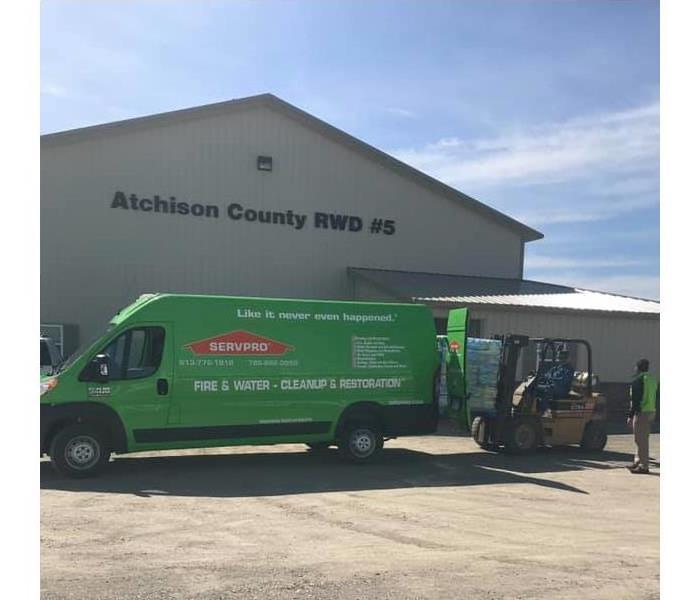 We are so happy to be able to help the people of Atchison county. Today we delivered 48 cases of water to help those in need.
We are so happy to be able to help the people of Atchison county. Today we delivered 48 cases of water to help those in need.
We are so happy to be able to help the people of Atchison county. Today we delivered 48 cases of water to help those in need. We hope the boil order is lifted soon.
As the waters of the Missouri River continue to rise here are some flood safety tips.
You should be cautious when driving or walking in flood-susceptible areas because:
- Six inches of moving water can knock you off your feet.
- Two feet of floodwater can float your car.
- Water moving at two miles-per-hour is capable of sweeping a car off a road or bridge.
- Avoid flood-susceptible areas, especially low-lying streets where water commonly pools. Never attempt to walk or drive through a water-covered roadway, and beware of rising, swift-moving water.
If you are driving and come upon rapidly rising waters, turn around and find another route. If your route is blocked by barricades, find another route. Barricades are put up by state or local officials to protect travelers from unsafe roads. Driving around them can be a serious risk.
The road may be washed out below the water surface.
Your vehicle may stall or get stuck in the water, and then get pushed off the road. Once off the road, vehicles often start to roll, making escape difficult or impossible.
Many flood-related deaths in the United States are the result of an attempt to move a stalled vehicle.
WATCH FOR WILD LIFE. Deer and other wildlife may be driven into the open and forced to cross highways to escape rising waters.
Stay safe out there everyone!
Expecting the unexpected
3/7/2019 (Permalink)
This time of year the weather in the Midwest is notoriously unpredictable-and let's be honest it's pretty much unpredictable all year round-and SERVPRO of Leavenworth and NW Wyandotte County is here to help you when disaster strikes. Whether that storm event comes in the form of frozen pipes, or tornadoes, or flooding, we are here to help 24 hours a day 7 days a week. With the recent drastic fluctuation in temperatures all areas of the United States have seen all kinds of storm damage and no matter where you are located there is likey to be a local SERVPRO Franchise ready and willing to help. To meet our highly trained crew of professional technicians just click here. And if you have any questions feel free to contact us at 913-772-1818.
Don't get swept away in this Kansas weather!
4/5/2018 (Permalink)
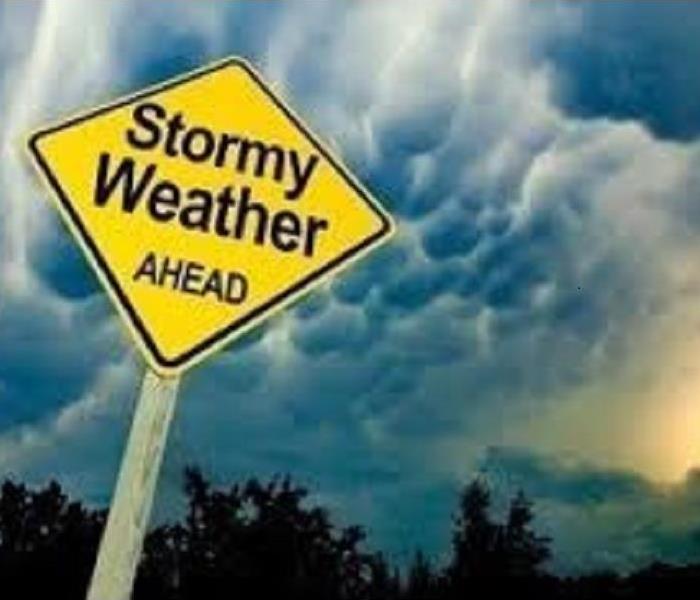 Be prepared for whatever weather we get in Kansas!
Be prepared for whatever weather we get in Kansas!
We all know how crazy the weather in Kansas can be in the spring time. There is never a better time to be prepared than before the storm hits! Be sure you know the difference between a watch and a warning.
Make sure your prepared with these tips from ready.gov
Flood Watch = “Be Aware.” Conditions are right for flooding to occur in your area.
Steps to Take
- Turn on your TV/radio. You will receive the latest weather updates and emergency instructions.
- Know where to go. You may need to reach higher ground quickly and on foot.
- Build or restock your emergency preparedness kit. Include a flashlight, batteries, cash, and first aid supplies.
Prepare Your Home
- Bring in outdoor furniture and move important indoor items to the highest possible floor. This will help protect them from flood damage.
- Disconnect electrical appliances and do not touch electrical equipment if you are wet or standing in water. You could be electrocuted.
- If instructed, turn off your gas and electricity at the main switch or valve. This helps prevent fires and explosions.
Flood Warning = "Take Action!" Flooding is either happening or will happen shortly.
Steps to Take
- Move immediately to higher ground or stay on high ground.
- Avoid walking or driving through flood waters. Turn Around, Don’t Drown! Just 6 inches of moving water can knock you down and 2 feet of water can sweep your vehicle away.
After the water recedes and your home has sustained damage don’t forget SERVPRO of Leavenworth is always here to help!
Call us at 913-772-1818
About SERVPRO of Leavenworth & NW Wyandotte Co.
SERVPRO of Leavenworth & NW Wyandotte Co. specializes in the cleanup and restoration of residential and commercial property after a fire, smoke or water damage event. Our staff is highly trained in property damage restoration. From initial and ongoing training at SERVPRO’s corporate training facility to regular IICRC-industry certification, rest assured our staff is equipped with the knowledge to restore your property.
Tornadoes ~ Are you Prepared?
3/13/2018 (Permalink)
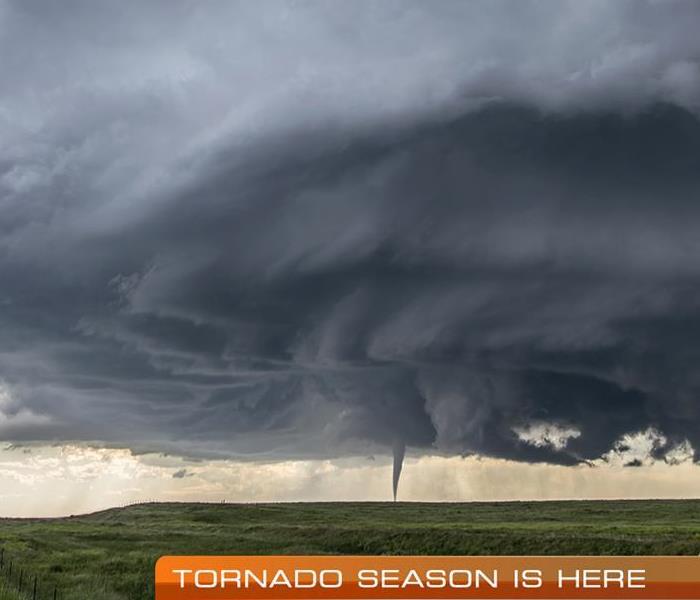 Tornado Season is Almost Upon Us! Be Prepared!
Tornado Season is Almost Upon Us! Be Prepared!
This page explains what actions to take when you receive a tornado watch or warning alert from the National Weather Service for your local area and what to do before, during, and after a tornado.
Know your risk
What
A tornado is a violently rotating column of air that extends from a thunderstorm to the ground and is often—although not always—visible as a funnel cloud. Lightning and hail are common in thunderstorms that produce tornadoes. Tornadoes cause extensive damage to structures and disrupt transportation, power, water, gas, communications, and other services in its direct path and in neighboring areas. Related thunderstorms can cause heavy rains, flash flooding, and hail
Where
About 1,200 tornadoes hit the United States every year and every state is at risk. Most tornadoes in the United States occur east of the Rocky Mountains with concentrations in the central and southern plains, the Gulf Coast and Florida.
When
Tornadoes can strike in any season, but occur most often in the spring and summer months. They can occur at all hours of the day and night, but are most likely to occur between 3 p.m. and 9 p.m.
Before a Tornado
- Identify safe rooms built to FEMA criteria or ICC500 storm shelters or other potential protective locations in sturdy buildings near your home, work, and other locations you frequent so you have a plan for where you will go quickly for safety when there is a Warning or an approaching tornado.
- For schools, malls, and other buildings with long-span roofs or open space plans, or many occupants, ask the building manager to identify the best available refuge.
- Build an emergency kit and make a family communications plan.
- Listen to NOAA Weather Radio or to commercial radio or television newscasts for the latest information. In any emergency, always listen to the instructions given by local emergency management officials.
- Be alert to changing weather conditions. Look for approaching storms.
- Look for the following danger signs:
- Dark, often greenish sky
- Large hail
- A large, dark, low-lying cloud (particularly if rotating)
- Loud roar, similar to a freight train.
- If you see approaching storms or any of the danger signs, be prepared to take shelter immediately.
Tornado Facts
The extent of destruction caused by tornadoes depends on the tornado’s intensity, size, path, time of day, and amount of time it is on the ground. Wind from tornadoes can reach more than 300 miles per hour, and damage paths can be more than 1 mile wide and 50 miles long. Wind from tornadoes can destroy buildings and trees, transform debris into deadly projectiles, and roll vehicles.
- They may strike quickly, with little or no warning.
- They may appear nearly transparent until dust and debris are picked up or a cloud forms in the funnel.
- The average tornado moves Southwest to Northeast, but tornadoes have been known to move in any direction.
- Tornadoes can accompany tropical storms and hurricanes as they move onto land.
- Waterspouts are tornadoes that form over water.
Know the Terms
Familiarize yourself with these terms to help identify a tornado hazard:
- Tornado Watch - Tornadoes are possible. When there is a Watch, move to be near enough to a shelter or sturdy building to be able to get there quickly in a few minutes if there is a Warning or if you see signs of a tornado approaching. Remain alert for approaching storms. Watch the sky and stay tuned to NOAA Weather Radio, commercial radio or television for information.
- Tornado Warning - A tornado has been sighted or indicated by weather radar. Take shelter immediately.
During a Tornado
If you are under a tornado warning, seek shelter immediately! Most injuries associated with high winds are from flying debris, so remember to protect your head.
If you are in school, nursing home, hospital, factory, shopping center, high-rise building pre-identified best available refuge then:
- Go to a pre-designated area such as a safe room built to FEMA criteria, or a small interior windowless room on the lowest level, below ground in a basement, or storm cellar, is best. (Closet, interior hallway) away from corners, windows, doors, and outside walls. Put as many walls as possible between you and the outside. Get under a sturdy table and cover your head and neck with your arms and cover your body as best you can e.g., with a heavy coat or blankets, pillows. .
- In a high-rise building, go to a small interior room or hallway on the lowest floor possible.
- Do not open windows.
- A sturdy structure (e.g. residence, small building) , school, nursing home, hospital, factory, shopping center, high-rise building)
A manufactured home or office then:
- Get out immediately and go to a pre-identified location such as the lowest floor of a sturdy, nearby building or a storm shelter. Mobile homes, even if tied down, do not offer protection from tornadoes.
The outside with no shelter then:
- If you are not in a sturdy building, there is no single research-based recommendation for what last-resort action to take because many factors can affect your decision. Possible actions include:
- Immediately get into a vehicle, buckle your seat belt and try to drive to the closest sturdy shelter. If your vehicle is hit by flying debris while you are driving, pull over and park.
- Take cover in a stationary vehicle. Put the seat belt on and cover your head with your arms and a blanket, coat or other cushion if possible.
- In all situations:
- Do not get under an overpass or bridge. You are safer in a low, flat location.
- Never try to outrun a tornado in urban or congested areas in a car or truck. Instead, leave the vehicle immediately for protection in a sturdy building. .
- Outdoor areas are not protected from flying debris. Flying debris from tornadoes causes most fatalities and injuries.
After a Tornado
- If you are trapped, do not move about or kick up dust. Tap on a pipe or wall or use a whistle, if you have one, so that rescuers can locate you.
- Listen to local officials for updates and instructions.
- Check-in with family and friends by texting or using social media.
- Watch out for debris and downed power lines.
- Stay out of damaged buildings and homes until local authorities indicate it is safe.
- Use extreme caution during post-disaster clean-up of buildings and around debris. Do not attempt to remove heavy debris by yourself. Wear protective clothing, including a long-sleeved shirt, long pants, work gloves, and sturdy, thick-soled shoes during clean-up.
- Photograph the damage to your property in order to assist in filing an insurance claim.
- Do what you can to prevent further damage to your property, (e.g., putting a tarp on a damaged roof), as insurance may not cover additional damage that occurs after the storm.
- If your home is without power, use flashlights or battery-powered lanterns rather than candles to prevent accidental fires.
Kansas weather can be unpredictable! Be informed & stay safe!
If tragedy strikes remember, SERVPRO of Leavenworth & NW Wyandotte Co. is always here to help!
913-772-1818
Spring weather can be unpredictable in Kansas. Reduce injury risk and plan ahead
4/18/2017 (Permalink)
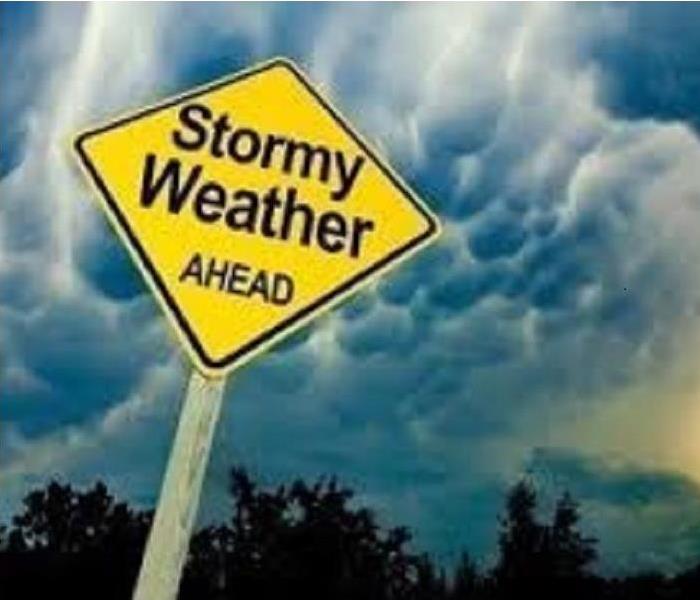 Often by the time we are aware of an approaching storm, we have little if any time to prepare for it.
Often by the time we are aware of an approaching storm, we have little if any time to prepare for it.
Spring is the time of year when many things change—including the weather. Temperatures can swing back and forth between balmy and frigid. Sunny days may be followed by a week of stormy weather. Sometimes extreme weather changes can occur even within the same day. Mark Twain once said, "In the spring I have counted one hundred and thirty-six kinds of weather inside of four and twenty hours."
Thunderstorms cause most of the severe spring weather. They can bring lightning, tornadoes, and flooding. Whenever warm, moist air collides with cool, dry air, thunderstorms can occur. For much of the world, this happens in spring and summer.
Because spring weather is so unpredictable, you may be unprepared when severe weather hits—particularly if you live in a region that does not often experience thunderstorms, tornadoes, or flooding. And when severe weather hits unexpectedly, the risk of injury and death increases. So planning ahead makes sense; prepare for storms, floods, and tornadoes as if you know in advance they are coming, because in the spring, they very likely will.
Advance planning for thunderstorms, lightning, tornadoes, and floods requires specific safety precautions. You can follow many of the same steps that you would for all extreme weather events. Keep an emergency kit on hand. Some items to include are:
- A battery-operated flashlight, a battery-operated NOAA Weather Radio, and extra batteries for both
- An emergency evacuation or shelter plan, including a map of your home and, for every type of severe weather emergency, routes to safety from each room
- A list of important personal information, including:
- telephone numbers of neighbors, family, and friends
- insurance and property information
- telephone numbers of utility companies
- medical information
- According to the American Red Cross a first aid kit may include:
- non-latex gloves
- assortment of adhesive bandages
- antibiotic ointment
- sterile gauze pads in assorted sizes
- absorbent compress dressings
- tweezers
- scissors
- adhesive cloth tape
- aspirin packets (81 mg each)
- first aid instruction booklet
(NOTE: Customize your first aid kit to meet your individual and family needs.)
- A 3–5 day supply of bottled water and nonperishable food
- Personal hygiene items
- Blankets or sleeping bags
- An emergency kit in your car
Prepare your family members for the possibility of severe weather. Tell them where to seek appropriate shelter as soon as they are aware of an approaching storm. Practice your emergency plan for every type of severe weather. Show family members where the emergency supplies are stored, and make sure they know how to turn off the water, gas, and electricity in your home.
Often by the time we are aware of an approaching storm, we have little if any time to prepare for it. But we do know that when spring arrives, thunderstorms, tornadoes, and floods are real possibilities. So why not take the surprise factor out of severe weather and prepare yourself, your family, and your home? If thunderstorms, tornadoes, and floods do occur, you'll be ready for them.
https://www.cdc.gov/features/springweather/
After the storms if you find you have damage to your home, don't forget SERVPRO is always here to help. 24/7 we are ready for whatever the weather leaves behind.
Call us today 913-772-1818

 24/7 Emergency Service
24/7 Emergency Service

























